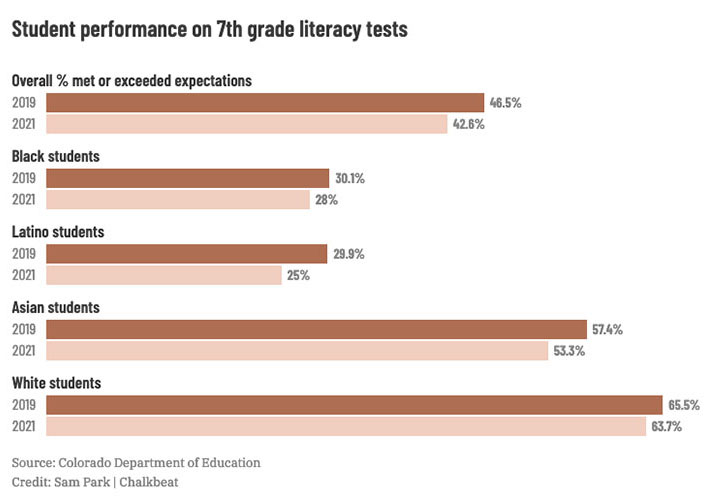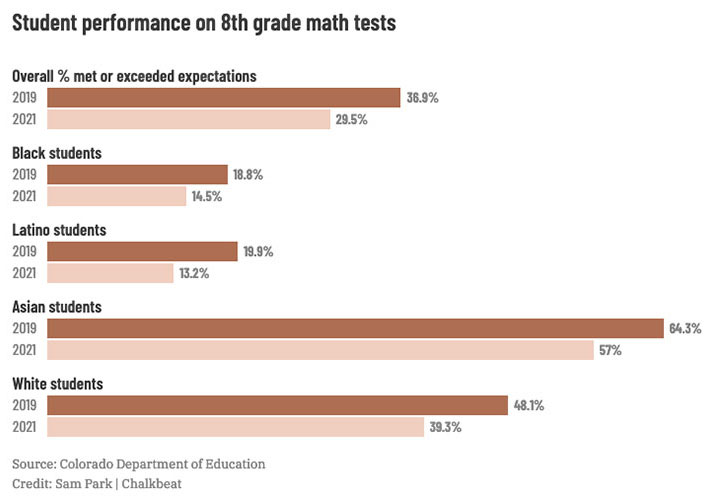This story by Erica Meltzer and Yesenia Robles appeared on Chalkbeat.org on August 12, 2021.
The Daily Post will comment on Archuleta School District CMAS scores when local data becomes available.
Colorado students’ performance on the CMAS (Colorado Measures of Academic Success) standardized tests declined across the board after a pandemic-disrupted school year, with larger drops for Hispanic students and those from low-income families. The test results provide the first statewide picture of student learning since 2019, as tests were canceled in 2020.
Data released Thursday shows that far fewer students took the tests, and those who did performed at levels last seen five to six years ago. Student performance fell more in math than in literacy, a trend that matches national patterns, with the drops particularly pronounced in middle school. Just 30% of eighth-graders who took the test met or exceeded grade level expectations, a decline of 7 percentage points from 2019.
Colorado students in grades three through eight typically take literacy and math tests known as the Colorado Measures of Academic Success, or CMAS, along with either a science or social studies test. This year, in a compromise between testing supporters and those who wanted to cancel the tests entirely, students in grades three, five, and seven took the literacy test, while students in grades four, six, and eight took the math test. Eighth graders also took the science test.
The tests administered in spring 2021 were significantly scaled back compared to 2019, and test participation plummeted, particularly in populous Denver metro area districts. That makes it difficult to draw firm conclusions, assessment experts said. But state education officials believe the results would have been even lower if more students participated. Unlike in past years, the test results will not be used to evaluate teachers or to rate schools and districts. The school accountability system is on pause.
Colorado Education Commissioner Katy Anthes said the results should create a sense of urgency around learning.
“These test results give us sobering data that confirm just how hard last year was with school closures, class quarantines, and remote learning,” Anthes said in a statement. “As students return to school, it is extremely clear that we must accelerate learning more than we have done historically. If we just go back to doing what we have done before, we will not be successful.”
District- and school-level data will be released at the end of the month. Parents should receive reports on their children’s individual performance soon.
While students took fewer tests, the tests themselves didn’t change, and students were still responsible for the same material.
“Students may have had reduced or disrupted learning opportunities. Students may have received instruction in new formats. Schools or districts may have chosen to reduce covered content,” said Joyce Zurkowski, chief assessment officer for the Colorado Department of Education. “The spring test, on the other hand, did not change in content or format.”
That consistency means the test provides a good measure of whether individual students mastered grade-level material and could be useful for parents and teachers in conjunction with other measurements, said Marianne Perie, an independent consultant who advises states on assessments.
But low participation makes it much harder to use the test results to make generalizations, which in turn makes it harder to set policy from them, she said. State officials and education advocates have said test results could be used to target money and help.
“The worst thing from a policy perspective would be to say, ‘You as a district did really well so you don’t get additional funds,’ but their 25% most at-risk kids didn’t test… and 10% of them weren’t in school at all,” she said.
Perie does not work with Colorado and had not seen Colorado’s results. She spoke with Chalkbeat to answer general questions about assessments in a pandemic.
In a typical year, the vast majority of Colorado students take CMAS tests, with participation rates above 95% among elementary students. This year, about three-quarters of third-graders took the literacy test, while just 58% of eighth-graders took their math test.
Black and Hispanic students took the tests at lower rates than their white peers, and students who qualify for subsidized meals — a measure of poverty — participated at lower rates than more affluent students. Fewer than 42% of Black eighth-graders took the math exam.
Black and Hispanic parents opted for remote learning at much higher rates than white families, and with no remote testing option, some may have skipped the test rather than send their children into school buildings they didn’t see as safe.
Low participation rates among students of color correlates strongly with low participation in the more diverse Denver metro area districts, state education officials said. Rural students also participated at rates below the state average, while students in urban and suburban districts outside of Denver participated at somewhat higher rates.
Low participation by these students makes it harder to reach conclusions about how students who had more disrupted schooling — whether because their school closed to in-person learning for weeks or months or because poor internet meant they couldn’t attend classes during quarantines — fared.
Among students who took the exam, just 39% of third graders met or exceeded grade level expectations in literacy, down 2 percentage points from 2019, and just 29% of fourth-graders met or exceeded expectations in math, a decline of 5 percentage points. At the middle school level, 43% of seventh-graders met or exceeded expectations, down 4 percentage points, while eight-grade math dropped 7 percentage points with just 30% of students at grade level.
The numbers for Black and Hispanic students were more than 20 percentage points lower, reflecting longstanding gaps in test performance that predate the pandemic. On many of the tests, Hispanic students and students from low-income households saw steeper declines than white students or more affluent ones.
Black students saw smaller declines from 2019 than other student groups on many tests, including third-grade reading and eighth-grade math. However, they had the lowest participation rates. Of students who took the test, fewer than a quarter of Black third-graders met or exceeded expectations in literacy. And just 15% of Black eighth graders scored at grade level in math.
Read Part Two, on Monday…


